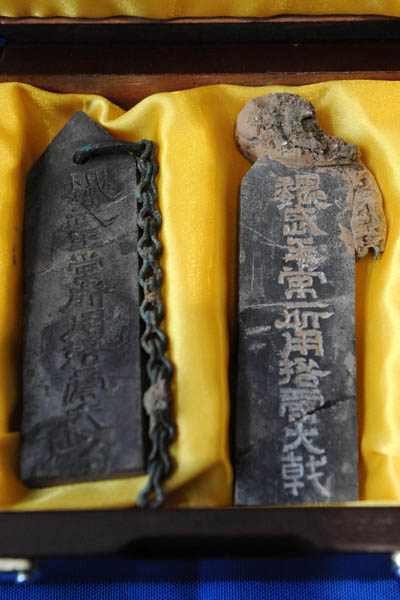-
News >China
Excavation of Cao Cao's tomb throws up new mysteries
2010-06-12 19:05ANYANG, Henan - Chinese archaeologists were Saturday still puzzling over the mysteries revealed in a live television broadcast of the excavation of an ancient general's tomb.

This photo taken on December 30, 2009 shows two stone plates excavated from the tomb of Cao Cao, a warlord during the Three Kingdoms period (208-280 A.D.), in Anyang of central China's Henan province. [Photo/Xinhua]The three-hour live broadcast by the China Central Television (CCTV) began at 9 am with experts invited to respond to doubts on the controversial claim that the site was the Mausoleum of General Cao Cao, a legendary warlord of the Three Kingdoms period (208-280 AD).
The archaeological society and amateurs had cast doubt on the claim before the State Administration of Cultural Heritage late Friday declared the find was one of the 10 top archaeological findings in China in 2009."The announcement indicates that the Chinese academic world has generally endorsed the authenticity of the tomb of Cao Cao in Anyang, although there are still many myths behind the legendary figure," said Sun Yingmin, deputy director of the Henan provincial bureau of cultural heritage.
The tomb is located near the Yellow River and in Xigaoxue village,Anyang, where Cao Cao ruled the Kingdom of Wei from 208 to 220, when he died at the age of 65.
The Henan Provincial Cultural Heritage Bureau announced the discovery of the tomb in December 2009, triggering nationwide interest in the ancient statesman, whose exploits were immortalized in the 14th Century historical novel "Romance of the Three Kingdoms", regarded as one of China's greatest literary works.
Cao Cao had been portrayed as intellectual, but scheming arch-careerist in Chinese art works.
Tomb's layout uncovered
The excavation undertaken by the Chinese Academy of Cultural Heritage has uncovered the layout of the mausoleum.
The square-shaped mausoleum comprises two pits covering 8,934 square meters. The No 2 pit has been identified as the coffin chamber of the tomb master, where a male skull, two female skulls and more than 250 relics have been unearthed.
The male skull suggested the man was aged over 60, and the females were aged about 20 and 50, but archaeologists have not reached conclusions on their identities.
Liu Shuguang, rector of the academy, said authorities were planning to build the mausoleum into a national archaeological relic park.
